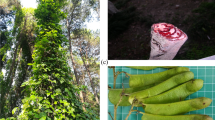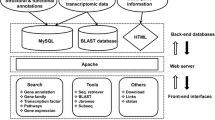Abstract
Vietnamese ginseng (Panax vietnamensis Ha et Grushv.), also known as Ngoc Linh ginseng, is a high-value herb in Vietnam. Vietnamese ginseng has been proven to be effective in enhancing the immune system, human memory, anti-stress, anti-inflammatory, anti-cancer, and prevent aging. The present study reports the first draft whole-genome of Vietnamese ginseng and the identification of potential genes involved in the triterpenoid metabolic pathway. De novo whole-genome assembly was performed successfully from a data of approximately 139 Gbps of 394,802,120 high quality reads to generate 9815 scaffolds with an N50 value of 572,722 bp from the leaf of Vietnamese ginseng. The assembled genome of Vietnamese ginseng is 3,001,967,204 bp long containing 79,374 gene models. Among them, there are 55,012 genes (69.30%) were annotated by various public molecular biology databases. The potential genes involved in triterpenoid saponin biosynthesis in Vietnamese ginseng and their metabolic pathway were also predicted.“ Three genes encoding squalene monooxygenase isozymes in Vietnamese ginseng were cloned, sequenced and characterized. Moreover, expression levels of several key genes involved in terpenoid biosynthesis in different parts of Vietnamese ginseng were also analyzed. The SSR markers were detected by various programs from both of assembly full dataset of Vietnamese ginseng genome and predicted genes. The present work provided important data of the draft whole-genome of Vietnamese ginseng for further studies to understand the role of genes involved in ginsenoside biosynthesis and their metabolic pathway at the molecular level of this rare medicinal species.










Similar content being viewed by others
References
Beier S, Thiel T, Münch T, Scholz U, Mascher M (2017) MISA-web: a web server for microsatellite prediction. Bioinformatics 33(16):2583–2585
Du L, Zhang C, Liu Q, Zhang X, Yue B (2018) Krait: An ultrafast tool for genome-wide survey of microsatellites and primer design. Bioinformatics 34(4):681–683
Duc NM, Kasai R, Yamasaki K, Nham NT, Tanaka O (1999) New dammarane saponins from Vietnamese ginseng. Studies in Plant Sci. 6:77–82
Han JY, In JG, Kwon YS, Choi YE (2010) Regulation of ginsenoside and phytosterol biosynthesis by RNA interferences of squalene epoxidase gene in Panax ginseng. Phytochemistry 71(1):36–46
Han S, Jeong AJ, Yang H, Kang KB, Lee H, Yi EH, Ye SK (2016) Ginsenoside 20 (S)-Rh2 exerts anti-cancer activity through targeting IL-6-induced JAK2/STAT3 pathway in human colorectal cancer cells. J Ethnopharmacol 194:83–90
He F, Zhu Y, He M, Zhang Y (2008) Molecular cloning and characterization of the gene encoding squalene epoxidase in Panax notoginseng. DNA Seq 19(3):270–273
Huong NTT, Matsumoto K, Yamasaki K, Duc NM, Nham NT, Watanabe H (1995) Crude sponin extracted from Vietnamese ginseng and its major constituent majonoside-R2 attenuate the psychological stress-and foot-shock stress-induced antinociception in mice. Pharmacol Biochem Behav 52(2):427–432
Jayakodi M, Choi BS, Lee SC, Kim NH, Park JY, Jang W, Yang TJ (2018) Ginseng Genome Database: an open-access platform for genomics of Panax ginseng. BMC Plant Biol 18(1):62. https://doi.org/10.1186/s12870-018-1282-9
Kim TD, Han JY, Huh GH, Choi YE (2011) Expression and functional characterization of three squalene synthase genes associated with saponin biosynthesis in Panax ginseng. Plant Cell Physiol 52(1):125–137
Kim K, Dong J, Wang Y, Park JY, Lee SC, Yang TJ (2017) Evolution of the Araliaceae family inferred from complete chloroplast genomes and 45S nrDNAs of 10 Panax-related species. Sci Rep 7(1):1–9
Kofler R, Schlötterer C, Lelley T (2007) SciRoKo: a new tool for whole genome microsatellite search and investigation. Bioinformatics 23(13):1683–1685
Konoshima T, Takasaki M, Ichiishi E, Murakami T, Tokuda H, Nishino H, Cancer Yamasaki K (1999) chemopreventive activity of majonoside-R2 from Vietnamese ginseng Panax vietnamensis. Cancer Lett. 147(1–2):11–16
Liu MH, Yang BR, Cheung WF, Yang KY, Zhou HF, Kwok JSL, Tsui SKW (2015) Transcriptome analysis of leaves roots and flowers of Panax notoginseng identifies genes involved in ginsenoside and alkaloid biosynthesis. BMC Genom. 16(1):265
Liu WJ, Lv HZ, He L, Song JY, Sun C, Luo HM, Chen SL (2016) Cloning and bioinformatic analysis of HMGS and HMGR genes from Panax notoginseng. Chinese Herbal Medic. 8(4):344–351
Liu J, Xu Y, Yang J, Wang W, Zhang J, Zhang R, Meng Q (2017) Discovery semisynthesis biological activities and metabolism of ocotillol-type saponins. J Ginseng Res 41:373–378
Luo H, Sun C, Sun Y, Wu Q, Li Y, Song J, Chen S (2011) Analysis of the transcriptome of Panax notoginseng root uncovers putative triterpene saponin-biosynthetic genes and genetic markers. BMC Genom 12(S5):S5
Mai TT, Moon J, Song Y, Viet PQ, Van Phuc P, Lee JM, Cho SK (2012) Ginsenoside F2 induces apoptosis accompanied by protective autophagy in breast cancer stem cells. Cancer Lett 321(2):144–153
Moriya Y, Itoh M, Okuda S, Yoshizawa AC, Kanehisa M. KAAS. 2007. An automatic genome annotation and pathway reconstruction server. Nucleic Acids Research. 101093/nar/gkm321
Nguyen B, Kim K, Kim YC, Lee SC, Shin JE, Lee J, Yang TJ. 2017. The complete chloroplast genome sequence of Panax vietnamensis Ha et Grushv. (Araliaceae). Mitochondrial DNA Part A. 28 (1):85–86
Niu Y, Luo H, Sun C, Yang TJ, Dong L, Huang L, Chen S (2014) Expression profiling of the triterpene saponin biosynthesis genes FPS, SS, SE, and DS in the medicinal plant Panax notoginseng. Gene 533(1):295–303
Shen HB, Chou KC (2007) Signal-3L: A 3-layer approach for predicting signal peptides. Biochem Biophys Res Commun 363(2):297–303
Tang H, Krishnakumar V, Li J. Jcvi. Jcvi Utility Libraries
Vu DD, Shah SNM, Pham MP, Nguyen MT, Nguyen TPT. 2020. De novo assembly and transcriptome characterization of an endemic species of Vietnam Panax vietnamensis Ha et Grushv. including the development of EST-SSR markers for population genetics. BMC Plant Biol. 20 358. https://doi.org/10.1186/s12870-020-02571-5
Wang W, Rayburn ER, Hao M, Zhao Y, Hill DL, Zhang R, Wang H (2008) Experimental therapy of prostate cancer with novel natural product anti-cancer ginsenosides. Prostate 68(8):809–819
Xu J, Chu Y, Liao B, Xiao S, Yin Q, Bai R, Chen S (2017) Panax ginseng genome examination for ginsenoside biosynthesis. Gigascience 6(11):1–15
Xu L, Dong Z, Fang L, Luo Y, Wei Z, Guo H, Wang Y (2019) OrthoVenn2: a web server for whole-genome comparison and annotation of orthologous clusters across multiple species. Nucleic Acids Res 47(1):52–58
Yamasaki K (2000) Bioactive saponins in Vietnamese ginseng. Panax Vietnamensis Pharmaceut. Biol 38(sup1):16–24
Zhang GH, Ma CH, Zhang JJ, Chen JW, Tang QY, He MH, Yang SC (2015) Transcriptome analysis of Panax vietnamensis var fuscidiscus discovers putative ocotillol-type ginsenosides biosynthesis genes and genetic markers. BMC Genom. 16(1):159
Acknowledgements
This research was financially supported by the National Foundation for Science and Technology Development (NAFOSTED), Vietnam (Grant number 106.02-2018.49).
Author information
Authors and Affiliations
Contributions
Loc NH, Tien NQD and Nhut DT conceived, designed, and performed the overall study. Ma X and Rombauts S performed genome assembly. Ma X, Rombauts S and Tien NQD performed genome annotation, gene ontology analysis, and prediction of genes involved in triterpenoid biosynthesis in Vietnamese ginseng. Tien NQD performed gene clusters analysis, detection of SSR markers, and prediction of metabolic pathways. Tien NQD, Man LQ, Chi DTK conducted full-length cloning of genes encoding squalene epoxidase isoenzymes and the analysis of their characteristics. Tien NQD, Nhut DT, Man LQ and Huy NX analyzed gene expression. Ut T provides samples. Tien NQD and Loc NH wrote and approved the final manuscript.
Corresponding author
Ethics declarations
Conflict of interest
All authors declared no conflict of interest.
Research involving human and animal rights
This study did not involve human and animal subjects.
Additional information
Publisher's Note
Springer Nature remains neutral with regard to jurisdictional claims in published maps and institutional affiliations.
Supplementary Information
Below is the link to the electronic supplementary material.
Rights and permissions
About this article
Cite this article
Tien, N.Q.D., Ma, X., Man, L.Q. et al. De novo whole-genome assembly and discovery of genes involved in triterpenoid saponin biosynthesis of Vietnamese ginseng (Panax vietnamensis Ha et Grushv.). Physiol Mol Biol Plants 27, 2215–2229 (2021). https://doi.org/10.1007/s12298-021-01076-1
Received:
Revised:
Accepted:
Published:
Issue Date:
DOI: https://doi.org/10.1007/s12298-021-01076-1




